Tuesday, October 1st, 2019 by Julian Karsunky
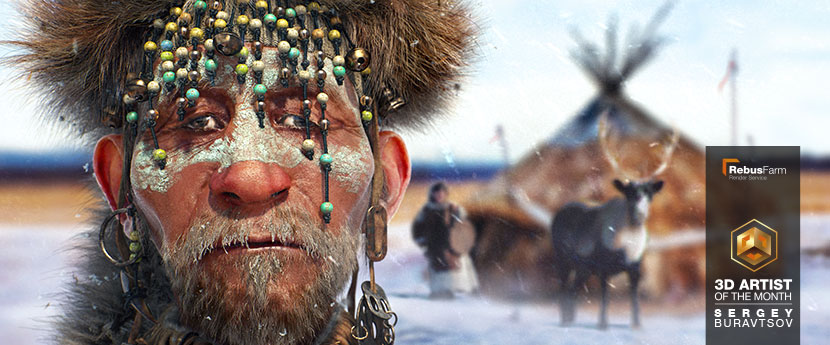
“Here’s looking at you, kid!” Sergey Buravtsov, our October 2019 3D Artist of the Month, takes us on a spiritual journey to the great plains of Northern Asia to meet ‘The Shaman’. Rich in expressiveness and ornate details, the elderly nomadic mystic greets the viewer with an equally captivating and knowing gaze.
While we’re not aiming to dispel the magic, we just had to find out more about the man behind the image. We sat down with Sergey to discuss his approach to character design, the importance of visual storytelling and the shamanistic lifestyle.
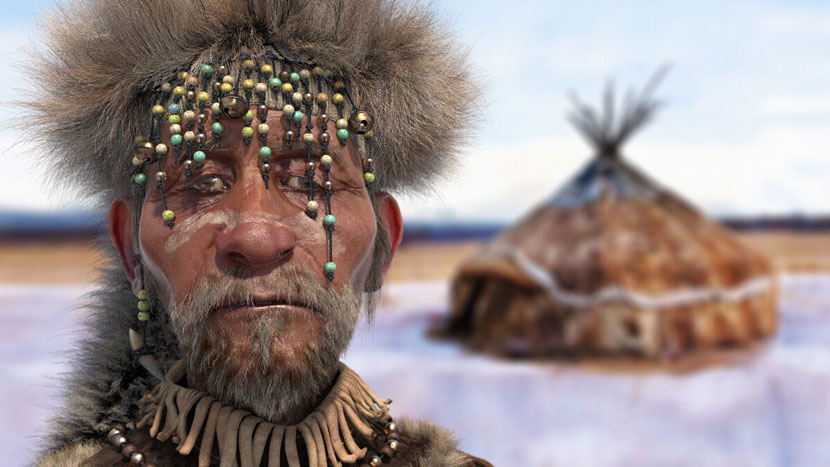 While it’s not easy to avert your eyes from the shaman’s piercing glance, it’s worth it to study Sergey’s meticulous work on the numerous details.
While it’s not easy to avert your eyes from the shaman’s piercing glance, it’s worth it to study Sergey’s meticulous work on the numerous details.
Hi Sergey, thanks for joining us today! To start things off, please introduce yourself to our readers!
Greetings, everybody! My name is Sergey Buravtsov, I’m 33 years old and I currently live and work in Moscow, Russia.
Do you recall when and how you first consciously encountered CGI?
I first became interested in 3D graphics in 2006, my initial software was 3ds Max 7. What started out as just a hobby, gradually turned into a job over time. Information was very hard to come by back then, so I had to piece everything together bit by bit, mostly through textbooks and online articles from Render.ru.
What training or education do you have?
I have a degree in industrial design. It was during my studies when I first learned the basics of 3D, as our training required us to visualize and present projects and assignments. On top of that, we also touched upon the basics of graphic, interior and web design.
How did the aforementioned shift towards a career in the CG industry happen, exactly?
At the start of my professional life, I was engaged in architectural interior visualization. Then, I became more and more fascinated with the possibilities of video production, though my first attempts looked more like simple animation tests. As I grew more proficient, I eventually decided to create a short clip with a deliberate plotline, focused on social issues. I submitted my video titled “TV Hostage” to several contests, and ended up winning second place at “Полигон для творчества” and first place in the international competition "Электронное перо 2010".
Following this success, I received a job offer as a 3D artist from NARR8, an interactive stories and motion comics startup. For the most part, I was working on environments, but I was also involved in the development of a suitable cel-shading style that would allow us to seamlessly integrate our hand-drawn 2D characters into 3D backgrounds. That, in particular, was an invaluable experience and being a part of a team of talented artists, I learned and grew a lot!
With my newly acquired experience, I went on to work as lead 3D artist at Game Insight in the video production for the next seven years.
 Although still at an early stage, you can already see the distinct look in those sunken eyes.
Although still at an early stage, you can already see the distinct look in those sunken eyes.
Please tell us more about your current job situation!
As of now, I’m working freelance and I am always on the lookout for large and interesting projects. My services include full CG video production, character creation, static advertising and interior visualization, though I’m increasingly focusing on social advertising. My client base consists of game developers, large advertising companies and interior design studios.
To you, what are the biggest advantages and challenges of self-employment?
The main advantage is obviously the freedom that comes with freelancing: you can manage your own work and leisure time as you like. What I miss the most is the exchange of knowledge and experience you get in an office environment on a daily basis.
What inspires you as a 3D artist?
The work of fellow 3D artists is what consistently motivates me to raise the bar and aspire to reach new heights in terms of quality. Periodically, I try to devote my free time to creative, non-commercial works. These personal projects are not only a welcome distraction from my professional routine, they also allow me to freely express ideas and expand my portfolio. In the process, I study new plugins and programs, which I can then apply to my main work, in turn. Learning by doing has always been the more interesting and useful approach to, as opposed to abstract, purely technical exercises.
 Sergey went above and beyond crafting the shaman’s facial features. While a lot of the lines and wrinkles are covered up in the final image, they’re still an important part of the character’s appearance.
Sergey went above and beyond crafting the shaman’s facial features. While a lot of the lines and wrinkles are covered up in the final image, they’re still an important part of the character’s appearance.
Now let us talk about your submission to our monthly contest in more detail, namely ‘The Shaman’, a nomad mystique travelling the wide planes of Northern Asia. First, please tell us about the idea and motivation for this project!
Generally speaking, each of my projects is somewhat of a technical exercise, since it is an expression of the level I’m currently at, especially when compared to my previous works. Still, at the beginning, there is always an idea. For this work, the idea came to me rather coincidentally. While walking around the city, I saw an old man with facial features similar to those of ‘The Shaman’, and so he became the prototype. This image sat in my head for a while and I began to look for references. Then, while searching for a suitable subject, I came across images of shamans and things fell into place at once.
My goal was to create a demanding, technically complex and detailed work. The abundance and combination of different materials on the various accessories allowed for just that!
What parts of the image were especially important to you, both from a technical and visual standpoint?
For me, the overall integrity of the image is what matters most. It is more than the sum of its parts, and every single detail has to attribute to that. Of course, considering the particular composition of ‘The Shaman’, the foreground and certain places on which emphasis is placed are especially important.
What were some of the challenges you had to overcome?
Throughout the creation of this piece, I generally had very little trouble, as I was walking a proven path, so to speak. The only problem I can think of would be miscalculating the hair during tests, I had to spend a lot of time on it. All in all, I spent around two months working on the image in my spare time.
What software did you use to create this piece? Any plug-ins you found particularly helpful?
My tools of choice for ‘The Shaman’ were ZBrush, 3ds Max, V-Ray , Unfold3D and Photoshop. I have been working with these programs for quite some time now and am very comfortable with them. In terms of plug-ins, I’m currently studying Ornatrix extensively, it’s very convenient for controlling hair and fur.
Can you tell us more about your inspirations and references regarding particular regions and tribes?
Ethnic themes are close to me, since I collect and play ethnic instruments myself. Mostly drums, there’s something in their primitive sound that really speaks to me. In this work, I wanted to capture and highlight this primitive state – the unity of man and nature.
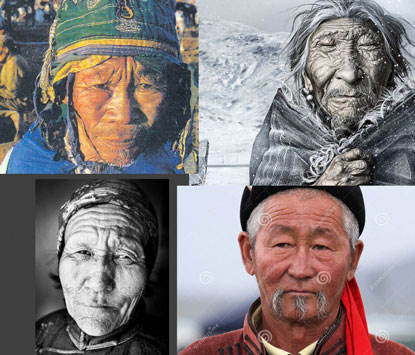 |
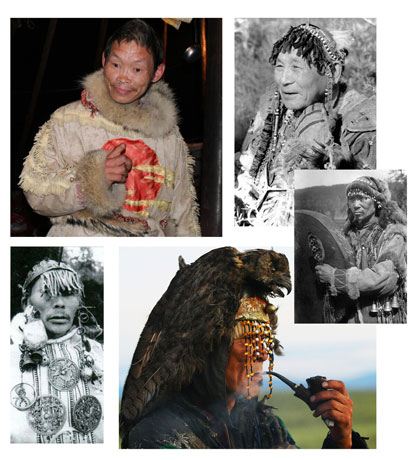 |
These reference sheets proved invaluable to the creation of ‘The Shaman’.
Once you had a rough concept in mind, how did you go about realizing your idea? Can you briefly walk us through the development process step by step?
Actually, there was not really an elaborate concept when I started, I developed the image step by step and added more and more details from the reference material I had gathered. The clothes and accessories I textured in Photoshop with almost even fillings of materials, then mixed them through various masks in 3ds Max, which gave more control over the materials.
In each work, I generally spent as much time as I can fleshing out the details on objects and characters. Working in irregularities and flaws in materials and geometry, as you would find them in real life, adds an amount of realism to the work that significantly reduces this synthetic feeling inherent to all 3D graphics. For similar reasons, I make a point to texture all the objects in the scene without exception, because naked shaders without textures immediately catch my eye.
If you’re further interested in the development process, I wrote an article in Russian detailing the making of ‘The Shaman’ here.
From the snowflakes in his beard to the ornate jewelry, the Shaman is a highly evocative figure. How did you approach this character in terms of visual storytelling?
In order for the work to be as authentic as possible, I studied the attributes of the shaman and their functions. All the details of his image are taken from real life sources!
Please tell us more about these details: What do the beads and bells in his headdress signify? What about the face paint or the charms around his neck?
These accessories are personal and or clan totems. The beads, bells and the bear claw are all objects of the shaman’s personal strength, representing the four kingdoms of nature: mineral, plant, animal, and human. The ring-shaped necklace symbolizes the circle of the shaman’s personality, and the beads strung on it serve to communicate with the subtle energies of its wearer.
The symbols of the medallions on the shaman’s neck indicate the owner’s special abilities and the purpose of his journey. For example, it could be an image of an animal closely associated with the shaman, a totem and a source of his strength and protection. Finally, the shaman’s face paint is used to invoke wind or rain according to the colors used. The blue paint on the shaman's face symbolizes springtime and clear skies, that is, it conjures spring.
 |
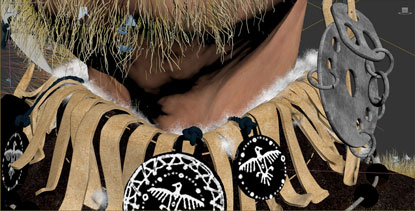 |
Work-in-progress images detailing the development of the shaman’s collar.
Personally, I am particularly impressed by the expressiveness of the Shaman’s eyes! What was the effect you wanted to create with his gaze and how did you achieve this?
I wanted to give him an expressive, yet contemplative look – the Shaman’s face is the focal point for the viewer, so it’s very important to immediately set the mood through his facial expression. I had to consult countless references and sort through many HDRI reflection maps, until I finally found just the right look. By the way, I initially created a faded, almost senile gaze, but the overall look wasn’t what I wanted, and so I redid the eyes later.
In your mind, what is ‘The Shaman’ like and what world does he live in?
The shaman is a chosen one among his people and serves those who visit him as a spiritual leader. He communicates with spirits, and uses a tambourine to journey to the beyond and back. His life is ascetic. The range of his skills is very wide and varied: curing diseases, attracting good luck and prosperity, guaranteeing successful hunting and fishing, praying for fertility and good weather conditions, eliminating dangers and troubles, natural disasters, and, of course, establishing contact between the souls of the dead and their living relatives.
How important is envisioning a backstory or personality for your characters in general and how does it factor into your designs?
Visual storytelling is essential to all of my works. So: in case of a character, I try to reflect personality through all means available, telling a story with the aesthetics, the environment, or by including symbolism. Atmosphere is something I pay I pay a lot of attention to, as well. There is a lot to be learned from classical paintings in that regard, from the depiction of nature, to lighting in portraits and dynamics in composition.
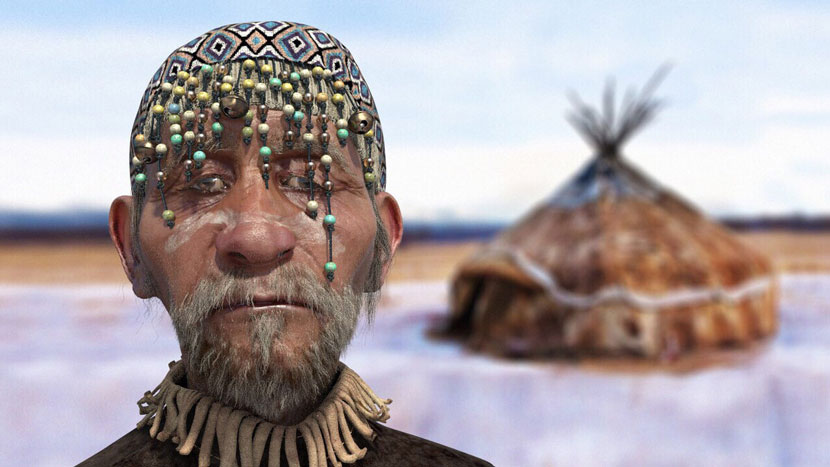 In case you were wondering “what is he wearing underneath all that fur?”, here is your answer! Also note the lack of jewelry at this point of development.
In case you were wondering “what is he wearing underneath all that fur?”, here is your answer! Also note the lack of jewelry at this point of development.
Speaking of composition, there is a clear division between the foreground and background, splitting the image in two almost right down the middle.
The composition of the image was conceived as a photo made by travelers who came to the shaman. The figures in the background are arranged in such a way as to create the planarity and depth of the image.
Have you used RebusFarm before? If yes, please tell us more about your overall experience. Is there anything you especially like about our service?
Unfortunately, I haven’t had a chance to use it yet. I have, however, heard a lot of great things about your service and am looking forward to try it out myself in the near future!
In closing, is there anything else you want to say? Any present or upcoming projects you’d like to mention?
I’d like to thank RebusFarm for this opportunity to talk and showcase my work.
 While this little edit Sergey blessed us with, certainly speaks for itself, it once again highlights his mastery of his character’s facial expressions, dramatically changing the mood with only minor changes!
While this little edit Sergey blessed us with, certainly speaks for itself, it once again highlights his mastery of his character’s facial expressions, dramatically changing the mood with only minor changes!
Thanks for reading, I wish you all the best of luck, lots of sunshine and happiness!
The same to you! Sergey, thank you very much for taking the time and all the best in the future!
Keep up with Sergey Buravtsov and his work here:
HOW TO JOIN OUR MONTHLY CONTEST
You want to be our next featured 3D Artist of the Month and win 250 RenderPoints? Just visit our 3D Artist of the Month competition page and submit your entry. We'll choose the best image and contact the winner.
>> Read more articles on our blog
